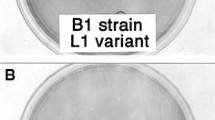Summary
If BHK-21 cell monolayer cultures are inoculated with Sindbis virus individual surviving cells can be observed, which are capable to multiply thereby forming small colonies in which the virus persists. The virus causes periodical cell destructions usually starting in the centers of the colonies. Increasing virus titers are observed during the phases of cell destruction and decreasing titers during the phases of cell growth. It takes several weeks for the slow growing colonies to form confluent cell sheets. Those cultures can be trypsinized and grown in continuous passages. The above mentioned periodical cell destructions then do no longer occur because a more stable equilibrium between BHK-21 cells and Sindbis virus has been established. About 6% of the cells are virus producers as evidenced by infective center tests. The supernatant contains approximately 104 to 105 PFU per 0,1 ml. The behaviour of the cells is changed concerning plaque formation by Sindbis virus if the persistent infection is eliminated by addition of immune serum. Cell morphology, however, remains unchanged. Virus from persistently infected cells differs also from the original virus: it produces smaller plaques in BHK-21 cell and chick embryo fibroblast cultures.
Similar content being viewed by others
References
Ahl, R.: Temperature-dependent interferon-sensitivity of foot-and-mouth disease virus. Arch. ges. Virusforsch.32, 163–170 (1970).
Ahl, R.: unpublished.
Bang, F. B., andG. O. Gey: Comparative susceptibility of cultured cell strains to the virus of eastern equine encephalomyelitis. Bull. Johns Hopk. Hosp.91, 427–461 (1952).
Bernhard, W., etP. Tournier: Infection virale inapparente de cellules de hamsters décelée par la microscopie électronique. Ann. Inst. Pasteur107, 447–452 (1964).
Cavalli-Sforza, L.: Biometrie. Grundzüge biologisch-medizinischer Statistik. 2. Aufl. Stuttgart: Verlag G. Fischer, 1969.
Cooper, P. D.: A method for producing plaques in agar suspensions of animal cells. Virology1, 397–401 (1955).
Dulbecco, R., andM. Vogt: Plaque formation and isolation of pure lines with poliomyelitis viruses. J. exp. Med.99, 167–182 (1954).
Eagle, H.: Nutrition needs of mammalian cells in tissue culture. Science122, 501–504 (1955).
Hampar, G., andM. L. Copeland: Persistent herpes simplex virus infection in vitro with cycles of cell destruction and regrowth. J. Bact.90, 205–212 (1965).
Henle, G., H. C. Hinze, andW. Henle: Persistent infection of L cells with polyoma virus: periodic destruction and repopulation of the cultures. J. nat. Cancer Inst.31, 125–141 (1963).
Kaaden, O., andB. Dietzschold: Isolation and characterization of extracellular virus-like particles from BHK cells. Arch. ges. Virusforsch.35, 317–321 (1971).
Kärber, G.: Beitrag zur kollektiven Behandlung pharmakologischer Reihenversuche. Naunyn-Schmiedeberg's Arch. exp. Path. Pharmak.162, 480–483 (1931).
Lorenz, R. J.: Zur Statistik des Plaque-Testes. Arch. ges. Virusforsch.12, 108–137 (1963).
McPherson, I., andM. Stoker: Polyoma transformation of hamster cell clones — an investigation of genetic factors affecting cell competence. Virology16, 147–151 (1962).
Mussgay, M., andR. Rott: Studies on the structure of a hemagglutinating component of a group A Arbo virus (Sindbis). Virology23, 573–581 (1964).
Schwöbel, W.: Die Plaque-Bildung des Virus der Maul- und Klauenseuche und ihre mathematische Analyse. Arbeiten der Universität Hohenheim Bd. 48. Stuttgart: Verl. Eugen Ulmer, 1969.
Schwöbel, W.: unpublished observation.
Schwöbel, W., undV. Siedentopf: Charakterisierung eines drei Jahre alten Zellstammes aus der Schweineniere und Untersuchungen über sein Verhalten gegenüber dem Virus der Maul- und Klauenseuche. Zbl. Bakt., I. Abt. Orig.181, 3–16 (1961).
Singh, K. R. P.: Cell cultures derived from larvae ofAedes albopictus (Skuse) andAedes aegypti (L.). Curr. Sci.36, 506–508 (1967).
Taylor-Papadimitriou, J., andM. Stoker: Effect of interferon on some aspects of transformation by polyoma virus. Nature New Biology230, 114–117 (1971).
Volterra, V.: Leçons sur la théorie mathématique de la lutte pour la vie. Cahiers scientifiques VII, Paris: Gauthier-Villars, 1931.
Author information
Authors and Affiliations
Rights and permissions
About this article
Cite this article
Schwöbel, W., Ahl, R. Persistence of Sindbis virus in BHK-21 cell cultures. Archiv f Virusforschung 38, 1–10 (1972). https://doi.org/10.1007/BF01241350
Received:
Issue Date:
DOI: https://doi.org/10.1007/BF01241350




